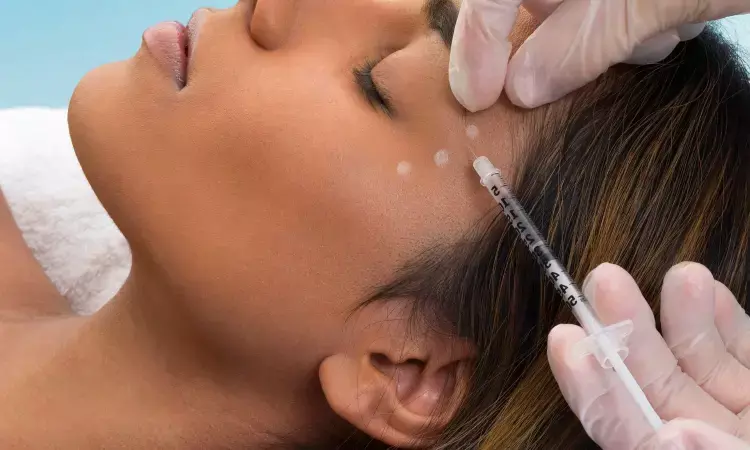- Home
- Medical news & Guidelines
- Anesthesiology
- Cardiology and CTVS
- Critical Care
- Dentistry
- Dermatology
- Diabetes and Endocrinology
- ENT
- Gastroenterology
- Medicine
- Nephrology
- Neurology
- Obstretics-Gynaecology
- Oncology
- Ophthalmology
- Orthopaedics
- Pediatrics-Neonatology
- Psychiatry
- Pulmonology
- Radiology
- Surgery
- Urology
- Laboratory Medicine
- Diet
- Nursing
- Paramedical
- Physiotherapy
- Health news
- Fact Check
- Bone Health Fact Check
- Brain Health Fact Check
- Cancer Related Fact Check
- Child Care Fact Check
- Dental and oral health fact check
- Diabetes and metabolic health fact check
- Diet and Nutrition Fact Check
- Eye and ENT Care Fact Check
- Fitness fact check
- Gut health fact check
- Heart health fact check
- Kidney health fact check
- Medical education fact check
- Men's health fact check
- Respiratory fact check
- Skin and hair care fact check
- Vaccine and Immunization fact check
- Women's health fact check
- AYUSH
- State News
- Andaman and Nicobar Islands
- Andhra Pradesh
- Arunachal Pradesh
- Assam
- Bihar
- Chandigarh
- Chattisgarh
- Dadra and Nagar Haveli
- Daman and Diu
- Delhi
- Goa
- Gujarat
- Haryana
- Himachal Pradesh
- Jammu & Kashmir
- Jharkhand
- Karnataka
- Kerala
- Ladakh
- Lakshadweep
- Madhya Pradesh
- Maharashtra
- Manipur
- Meghalaya
- Mizoram
- Nagaland
- Odisha
- Puducherry
- Punjab
- Rajasthan
- Sikkim
- Tamil Nadu
- Telangana
- Tripura
- Uttar Pradesh
- Uttrakhand
- West Bengal
- Medical Education
- Industry
Botulinum toxin useful therapeutic option to improve cutaneous flushing, finds study

Cutaneous flushing is a common dermatologic concern often resistant to conventional treatments.Oral medication or light-based therapies including laser or intense pulsed therapy may not be effective in some cases of persistent erythema and flushing. Intradermal botulinum toxin A (BTX-A) injection can be used to treat intractable erythema and flushing, but studies with large samples and long-term observation have not been conducted to determine its effectiveness and safety.
A new research suggests that botulinum toxin, known for its diverse therapeutic applications, may offer relief for flushing symptoms. This study was aimed to evaluate the efficacy of botulinum toxin in treating cutaneous flushing.
This study was published in the journal of Dermatologic Surgery by Vincent and colleagues. A systematic review of databases including Medline, Embase, Cochrane CENTRAL, CINAHL, Scopus, and Web of Science was conducted to identify studies assessing the effect of botulinum toxin on flushing. Prespecified outcome measures included clinical flushing score, dermatology life quality index (DLQI), and erythema index (EI).
Meta-analysis was performed to calculate mean differences in these outcomes before and after botulinum toxin treatment at 1-month follow-up.
Nine studies involving 132 patients were included in the analysis, comprising 2 randomized controlled trials and 7 nonrandomized studies.
All studies demonstrated a low risk of bias, indicating high quality.
The meta-analysis revealed a significant decrease in clinical flushing scores by 1.25 points overall (95% confidence interval [CI]: −2.47; −0.04) 1 month after botulinum toxin treatment.
Mean DLQI scores improved by 9.02 points (95% CI: −19.81; 1.77) following botulinum toxin injections.
Although the EI (measured by Mexameter) showed improvement in 2 studies, statistical analysis was inconclusive due to insufficient data.
This meta-analysis provides evidence that botulinum toxin effectively reduces clinical flushing scores 1 month after treatment. This finding underscores the potential of botulinum toxin as a therapeutic option for managing cutaneous flushing, offering hope for individuals with this challenging dermatologic condition.
Reference:
Vincent, N., Ravipati, A., Reynolds, J. M., & Kaufman, J. (2024). Efficacy of botulinum toxin in the treatment of cutaneous flushing: A systematic review and meta-analysis. Dermatologic Surgery, 10.1097/DSS.0000000000004073. https://doi.org/10.1097/dss.0000000000004073
Dr Riya Dave has completed dentistry from Gujarat University in 2022. She is a dentist and accomplished medical and scientific writer known for her commitment to bridging the gap between clinical expertise and accessible healthcare information. She has been actively involved in writing blogs related to health and wellness.
Dr Kamal Kant Kohli-MBBS, DTCD- a chest specialist with more than 30 years of practice and a flair for writing clinical articles, Dr Kamal Kant Kohli joined Medical Dialogues as a Chief Editor of Medical News. Besides writing articles, as an editor, he proofreads and verifies all the medical content published on Medical Dialogues including those coming from journals, studies,medical conferences,guidelines etc. Email: drkohli@medicaldialogues.in. Contact no. 011-43720751


